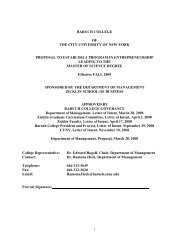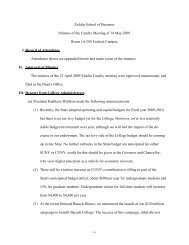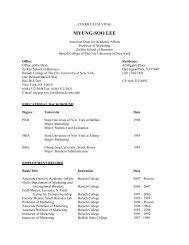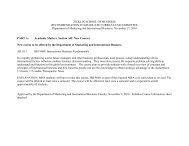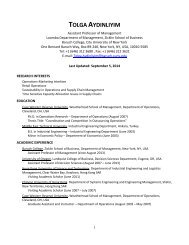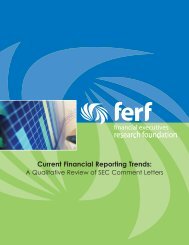Tax Seminar #3 – December 3 2012
Workbook - Zicklin School of Business
Workbook - Zicklin School of Business
Create successful ePaper yourself
Turn your PDF publications into a flip-book with our unique Google optimized e-Paper software.
Internal Revenue Manual - 5.8.5 Financial Analysis<br />
Page 2 of 3<br />
A taxpayer is in poor health and their<br />
ability to continue working is<br />
questionable<br />
A taxpayer is close to retirement and<br />
has indicated they will be retiring<br />
In this case, you should consider income averaging the prior three years or secure a future income<br />
collateral agreement if the offer is accepted.<br />
Note:<br />
This practice does not apply to wage earners. Wage earners should be based on current income<br />
unless the taxpayer has unique circumstances.<br />
Reduce the number of payments to the appropriate number of months it is anticipated the taxpayer will<br />
continue working. Consider special circumstance situations when making any adjustments.<br />
Example:<br />
<strong>Tax</strong>payer has a serious health issue and it is anticipated they will be unable to work after six months.<br />
Use the taxpayer’s current income for six months then reduce their income to the anticipated amount<br />
they will be receiving after they are unable to work.<br />
If the taxpayer can substantiate retirement is imminent, adjust the taxpayer’s future earnings and<br />
expenses accordingly. If it cannot be substantiated, base the calculation on current earnings. At this<br />
point, it may be appropriate to discuss other options available to the taxpayer, for example an<br />
installment agreement.<br />
Example:<br />
(1) The taxpayer is 65 years of age and has indicated they will retire at the age of 66. They provide<br />
copies of documents that have been submitted to their employer discussing their retirement date. Use<br />
the taxpayer’s current income until the taxpayer’s anticipated retirement date, then adjust the<br />
taxpayer’s income to reflect the amount expected in retirement.<br />
Example:<br />
A taxpayer will file a petition for<br />
liquidating bankruptcy<br />
(2) The taxpayer is 62 years of age, the taxpayer is in good health, and their income has remained<br />
stable for the past three years. The taxpayer states they would like to retire at age 65. Use the<br />
taxpayer’s current income and if the RCP exceeds the offer amount, discuss the option of securing an<br />
installment agreement until the taxpayer actually retires, at which time an offer may be appropriate.<br />
Consider reducing the value of future income. The total value of future income should not be reduced<br />
to an amount less than what could be paid toward non-dischargeable periods, or what could be<br />
recovered through bankruptcy, whichever is greater. When considering a reduction in future income,<br />
also consider the intangible value to the taxpayer of avoiding bankruptcy. Refer to IRM 5.8.10.2.<br />
5. Judgment should be used in determining the appropriate time to apply income averaging on a case by case basis. All circumstances of the<br />
taxpayer should be considered when determining the appropriate application of income averaging, including special circumstances and ETA<br />
considerations. Below are some examples of when income averaging may or may not be appropriate.<br />
Example:<br />
(1) <strong>Tax</strong>payer’s spouse has not worked for over two and one-half years and has no expectations of returning to work. Do not average income<br />
for the spouse's past employment.<br />
Example:<br />
(2) <strong>Tax</strong>payer has been unemployed for over one year and provided proof that Social Security Disability is the sole source of income. Do not<br />
apply income averaging in this case but use current income to determine the taxpayer’s future ability to pay.<br />
Example:<br />
(3) The taxpayer was incarcerated and unable to work for the past four years and provided proof that a relative is paying for all expenses,<br />
including child support payments. The taxpayer has no skills or promise of work in the near future but is planning on attending trade school to<br />
improve his chances of getting a job. Do not include income prior to the incarceration. In this case, since the taxpayer has no skills or<br />
promise of employment, their future income value may be determined to be zero. Consideration should be given whether it would be in the<br />
best interest of the government to accept the offer or reject the offer in favor of other case resolutions.<br />
Example:<br />
(4) The taxpayer recently began working after several months of unemployment. Use the most recent three months pay statements to<br />
determine future income. Since the taxpayer is a wage earner, the use of income averaging over the prior three years of income is not<br />
appropriate.<br />
6. In situations where the taxpayer’s income does not appear to meet their stated living expenses the difference should not be included as<br />
additional income to the taxpayer, unless there are clear indications additional income not included on the collection information statement is<br />
being received and will continue to be received by the taxpayer. Discussion with the taxpayer/POA and a review of documents submitted by<br />
the taxpayer must take place to determine the appropriateness of including an additional amount in the calculation of future income.<br />
Verification of the source of unexplained bank deposits or statements from the source of gifts may be required to correctly determine the<br />
http://www.irs.gov/irm/part5/irm_05-008-005.html<br />
44





